High-Power, Narrow-Linewidth, Continuous-Wave, Thulium-Doped Fiber Laser Based on MOPA
Abstract
1. Introduction
2. Experimental Setup
3. Experimental Results
4. Conclusions
Author Contributions
Funding
Institutional Review Board Statement
Informed Consent Statement
Data Availability Statement
Conflicts of Interest
References
- Zheng, H.; Zhang, J.; Guo, N.; Zhu, T. Distributed optical fiber sensor for dynamic measurement. J. Light. Technol. 2021, 39, 3801–3811. [Google Scholar] [CrossRef]
- Agger, S.; Povlsen, J.H.; Varming, P. Single-frequency thulium-doped distributed-feedback fiber laser. Opt. Lett. 2004, 29, 1503–1505. [Google Scholar] [CrossRef] [PubMed]
- Henderson, S.W.; Suni, P.J.M.; Hale, C.P.; Hannon, S.M.; Magee, J.R.; Bruns, D.L.; Yuen, E.H. Coherent laser radar at 2 μm using solid-state lasers. IEEE Trans. Geosci. Remote Sens. 1993, 31, 4–15. [Google Scholar] [CrossRef]
- Koch, G.J.; Beyon, J.Y.; Barnes, B.W.; Petros, M.; Yu, J.; Amzajerdian, F.; Kavaya, M.J.; Singh, U.N. High-energy 2 μm Doppler lidar for wind measurements. Opt. Eng. 2007, 46, 116201. [Google Scholar]
- Liao, R.; Song, Y.; Liu, W.; Shi, H.; Chai, L.; Hu, M. Dual-comb spectroscopy with a single free-running thulium-doped fiber laser. Opt. Express 2018, 26, 11046–11054. [Google Scholar] [CrossRef]
- Moulton, P.F.; Rines, G.A.; Slobodtchikov, E.V.; Wall, K.F.; Frith, G.; Samson, B.; Carter, A.L.G. Tm-doped fiber lasers: Fundamentals and power scaling. IEEE J. Sel. Top. Quantum Electron. 2009, 15, 85–92. [Google Scholar] [CrossRef]
- Jackson, S.D. Towards high-power mid-infrared emission from a fibre laser. Nat. Photonics 2012, 6, 423–431. [Google Scholar] [CrossRef]
- Geng, J.; Wang, Q.; Jiang, S. 2 μm fiber laser sources their applications. In Proceedings of the Nanophotonics Macrophotonics for Space Environments, V, San Diego, CA, USA, 21–25 August 2011; SPIE-International Society for Optical Engineering: Bellingham, WA, USA, 2011; Volume 8164, pp. 79–88. [Google Scholar]
- Sarp, A.S.K.; Gulsoy, M. Determining the optimal dose of 1940-nm thulium fiber laser for assisting the endodontic treatment. Lasers Med. Sci. 2017, 32, 1507–1516. [Google Scholar] [CrossRef]
- Ahmadi, P.; Estrada, A.; Katta, N.; Lim, E.; McElroy, A.; Milner, T.E.; Mokan, V.; Underwood, M. 1940 nm all-fiber Q-switched fiber laser. In Proceedings of the Fiber Lasers XIV: Technology and Systems, San Francisco, CA, USA, 28 January–2 February 2017; SPIE-International Society for Optical Engineering: Bellingham, WA, USA, 2017; Volume 10083, pp. 71–77. [Google Scholar]
- Yang, C.; Ju, Y.L.; Yao, B.Q.; Dai, T.Y.; Duan, X.M.; Zhang, Z.G.; Liu, W. 140 W high power all-fiber laser at 1940 nm with narrow spectral line-width by MOPA configuration. Appl. Phys. B 2016, 122, 230. [Google Scholar] [CrossRef]
- Zhang, Z.; Boyland, A.J.; Sahu, J.K.; Clarkson, W.A.; Ibsen, M. High-power single-frequency thulium-doped fiber DBR laser at 1943 nm. IEEE Photonics Technol. Lett. 2011, 23, 417–419. [Google Scholar] [CrossRef]
- Frith, G.; Carter, A.; Samson, B.; Town, G. Design considerations for short-wavelength operation of 790-nm-pumped Tm-doped fibers. Appl. Opt. 2009, 48, 5072–5075. [Google Scholar] [CrossRef]
- Liu, K.; Liu, J.; Shi, H.; Tan, F.; Wang, P. High power mid-infrared supercontinuum generation in a single-mode ZBLAN fiber with up to 21.8 W average output power. Opt. Express 2014, 22, 24384–24391. [Google Scholar] [CrossRef]
- Simakov, N.; Davidson, A.; Hemming, A.; Bennetts, S.; Hughes, M.; Carmody, N.; Davies, P.; Haub, J. Mid-infrared generation in ZnGeP2 pumped by a monolithic, power scalable 2-µm source. In Proceedings of the Fiber Lasers IX: Technology, Systems, and Applications, San Francisco, CA, USA, 21–26 January 2012; SPIE-International Society for Optical Engineering: Bellingham, WA, USA, 2012; Volume 8237, pp. 559–564. [Google Scholar]
- Liu, J.; Liu, K.; Shi, H.; Hou, Y.; Jiang, Y.; Wang, P. 210 W single-frequency, single-polarization, thulium-doped all-fiber MOPA. Opt. Express 2014, 22, 13572–13578. [Google Scholar] [CrossRef]
- Shi, H.; Liu, J.; Liu, K.; Tan, F.; Wang, P. 160 W average power single-polarization, nanosecond pulses generation from diode-seeded thulium-doped all fiber MOPA system. In Proceedings of the Fiber Lasers XII: Technology, Systems, and Applications, San Francisco, CA, USA, 7–12 February 2015; SPIE-International Society for Optical Engineering: Bellingham, WA, USA, 2015; Volume 9344, pp. 258–263. [Google Scholar]
- Yao, B.Q.; Li, H.; Li, X.L.; Chen, Y.; Duan, X.M.; Bai, S.; Yang, H.Y.; Cui, Z.; Shen, Y.J.; Dai, T.Y. An actively mode-locked Ho: YAG solid-laser pumped by a Tm-doped fiber laser. Chin. Phys. Lett. 2016, 33, 044205. [Google Scholar] [CrossRef]
- Geng, J.; Wang, Q.; Luo, T.; Jiang, S.; Amzajerdian, F. Single-frequency narrow-linewidth Tm-doped fiber laser using silicate glass fiber. Opt. Lett. 2009, 34, 3493–3495. [Google Scholar] [CrossRef]
- Hu, J.; Menyuk, C.R.; Shaw, L.B.; Sanghera, J.S.; Aggarwal, I.D. Computational study of 3–5 μm source created by using supercontinuum generation in As 2 S 3 chalcogenide fibers with a pump at 2 μm. Opt. Lett. 2010, 35, 2907–2909. [Google Scholar] [CrossRef]
- Lippert, E.; Fonnum, H.; Stenersen, K. High power multi-wavelength infrared source. In Proceedings of the Technologies for Optical Countermeasures VII, Toulouse, France, 20–23 September 2010; SPIE-International Society for Optical Engineering: Bellingham, WA, USA, 2010; Volume 7836, pp. 99–104. [Google Scholar]
- Yin, K.; Yang, W.; Zhang, B.; Li, Y.; Hou, J. Microsecond gain-switched master oscillator power amplifier (1958 nm) with high pulse energy. Quantum Electron. 2014, 44, 163. [Google Scholar] [CrossRef] [PubMed]
- Jackson, S.D.; King, T.A. Theoretical modeling of Tm-doped silica fiber lasers. J. Light. Technol. 1999, 17, 948. [Google Scholar] [CrossRef]
- Mihalcea, R.M.; Webber, M.E.; Baer, D.S.; Hanson, R.K.; Feller, G.S.; Chapman, W.B. Diode-laser absorption measurements of CO2, H2O, N2O, and NH3 near 2.0 μm. Appl. Phys. B 1998, 67, 283–288. [Google Scholar] [CrossRef]
- Shi, W.; Petersen, E.B.; Moor, N.; Chavez-Pirson, A.; Peyghambarian, N. Single frequency actively Q-switched 2 µm fiber laser by using highly Tm-doped Germanate fiber. In CLEO: Science and Innovations; Optica Publishing Group: Washington, DC, USA, 2011; p. CThDD6. [Google Scholar]
- Blackmon, R.L.; Case, J.R.; Trammell, S.R.; Irby, P.B.; Fried, N.M. Fiber-optic manipulation of urinary stone phantoms using holmium: YAG and thulium fiber lasers. J. Biomed. Opt. 2013, 18, 028001. [Google Scholar] [CrossRef]
- Wenk, S.; Furst, S.; Danicke, V.; Kunde, D.T. Design and technical concept of a Tm laser scalpel for clinical investigation based on a 60 W, 1.92 μm Tm fiber laser system. Adv. Med. Eng. V 2007, 114, 447–452. [Google Scholar]
- Stachowiak, D.; Kaczmarek, P.; Abramski, K.M. High-power pump combiners for Tm-doped fibre lasers. Opto-Electron. Rev. 2015, 23, 259–264. [Google Scholar] [CrossRef]
- Pei, W.; Li, H.; Cui, Y.; Zhou, Z.; Wang, M.; Wang, Z. Narrow-linewidth 2 μm all-fiber laser amplifier with a highly stable and precisely tunable wavelength for gas molecule absorption in photonic crystal hollow-core fibers. Molecules 2021, 26, 5323. [Google Scholar] [CrossRef]
- Wang, J.; Yeom, D.; Lee, S.B.; Lee, K. 28 W CW linearly polarized single mode all-fiber thulium-doped fiber laser operating at 1.95 μm. Opt. Eng. 2017, 56, 046108. [Google Scholar] [CrossRef]
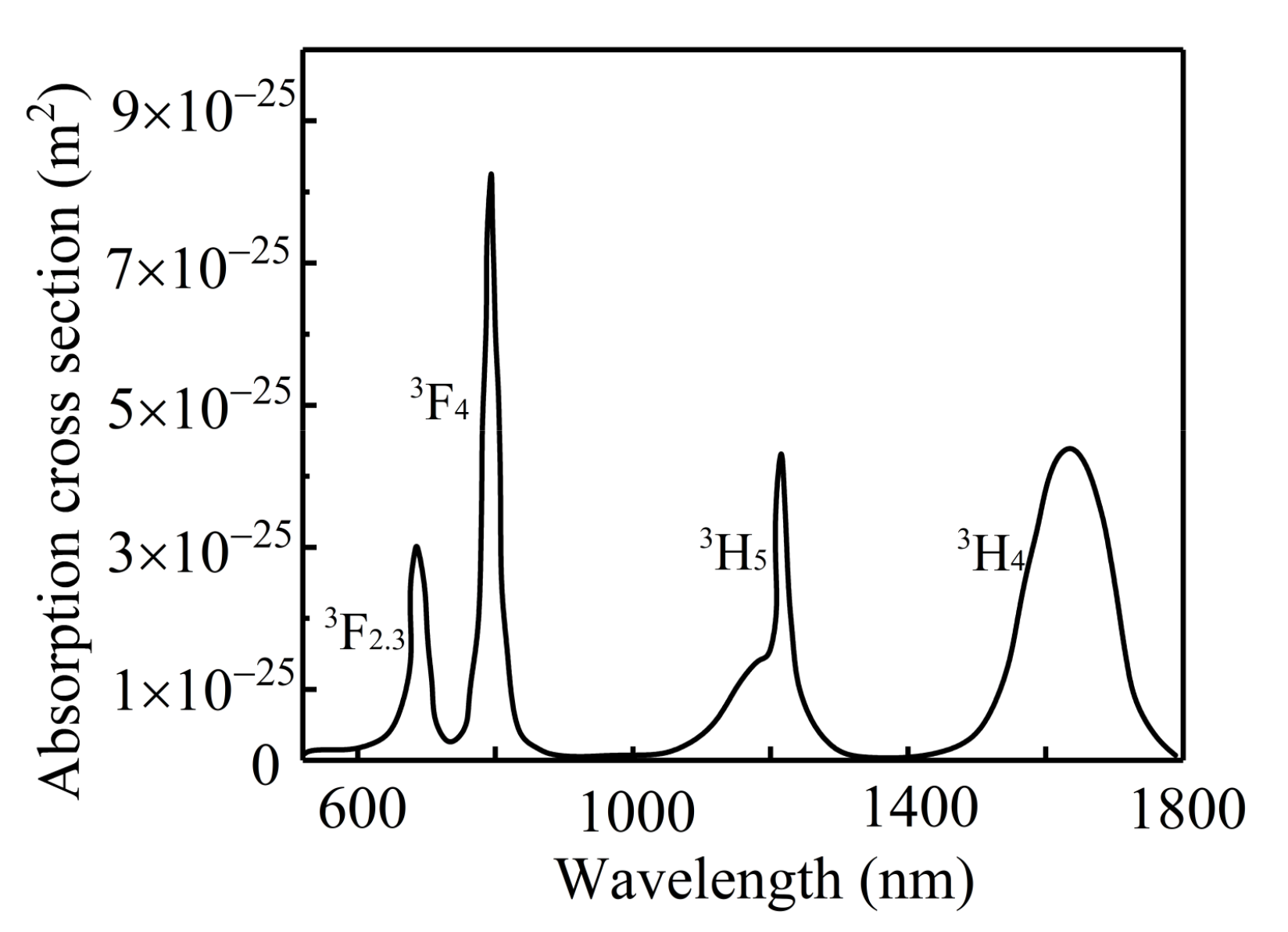
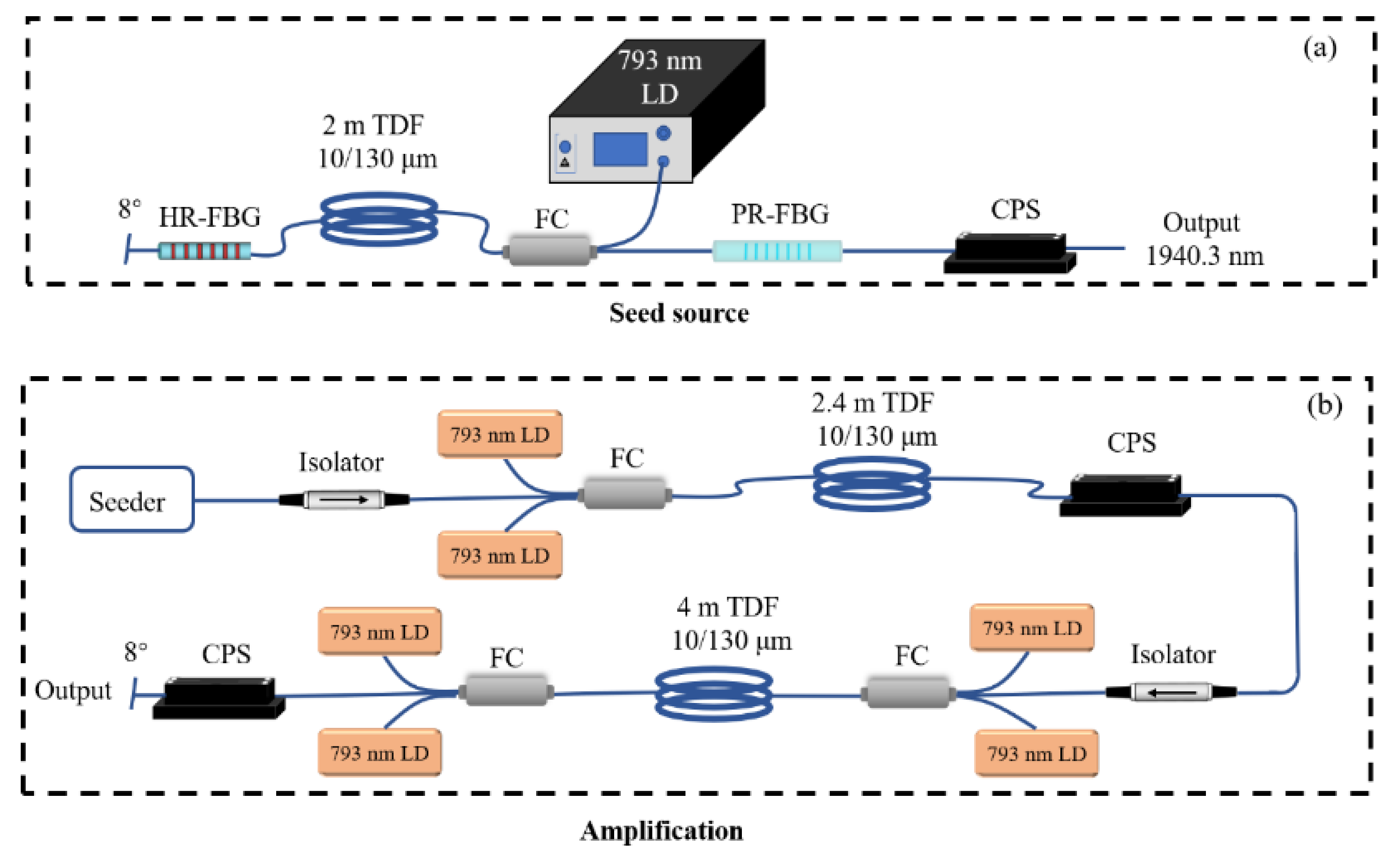
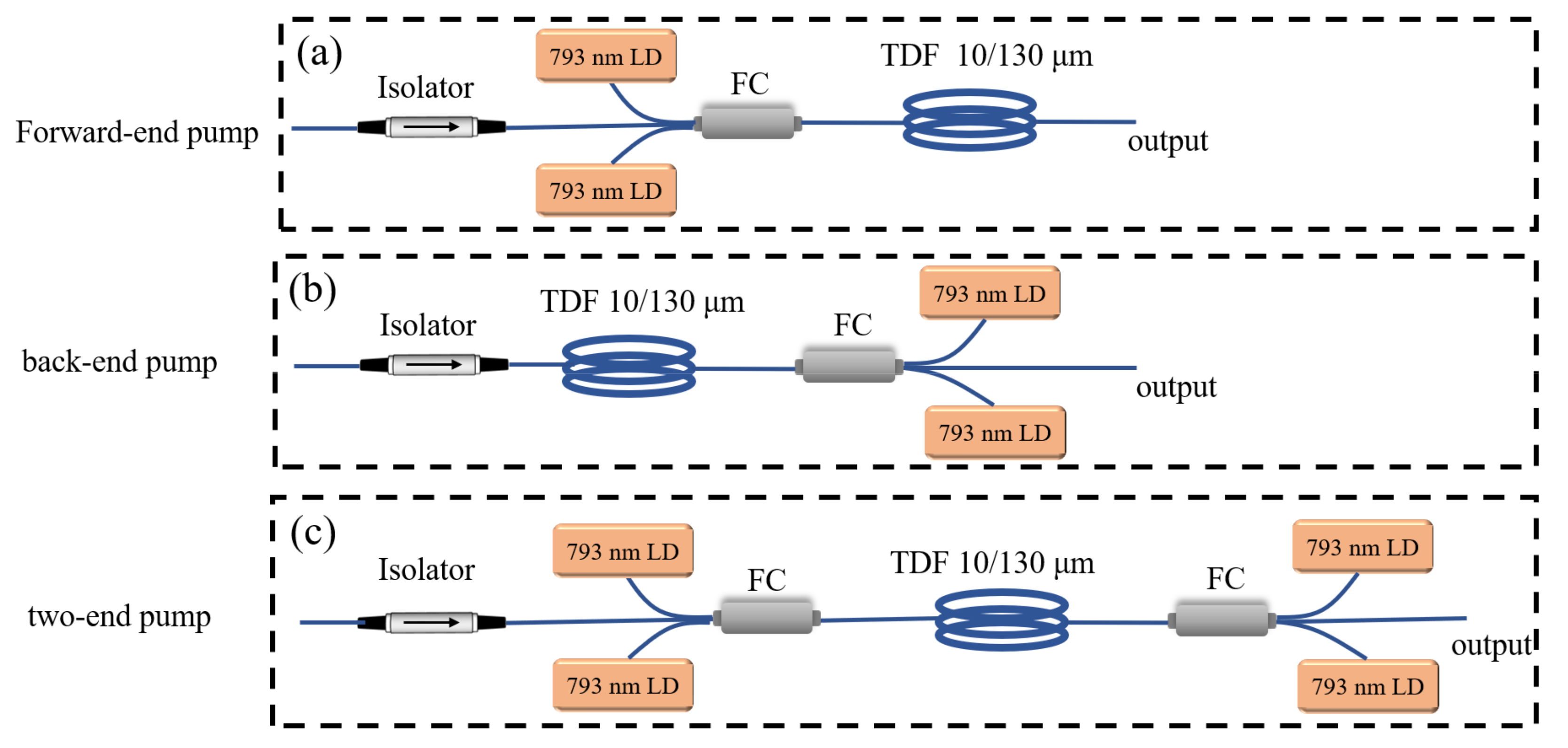

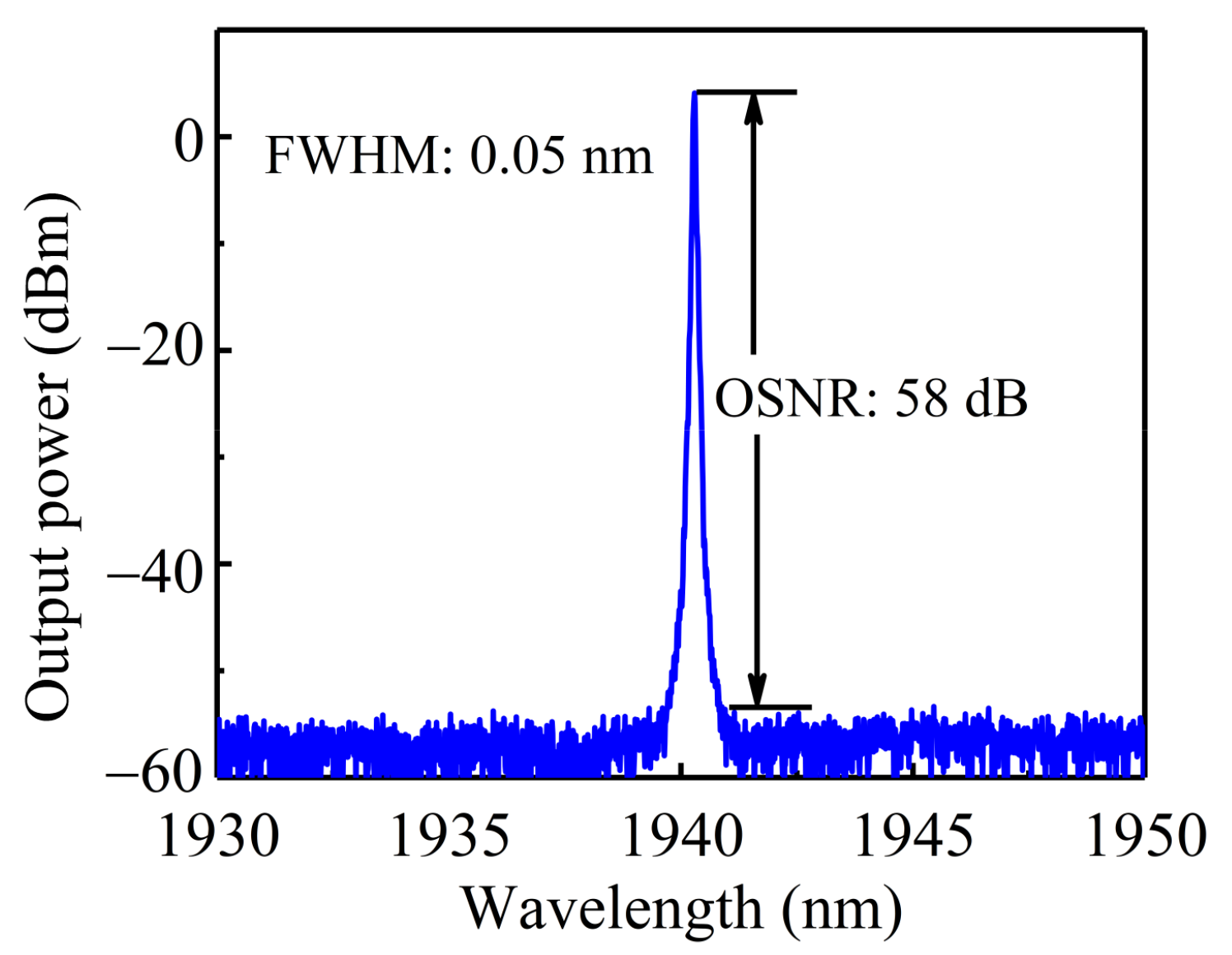
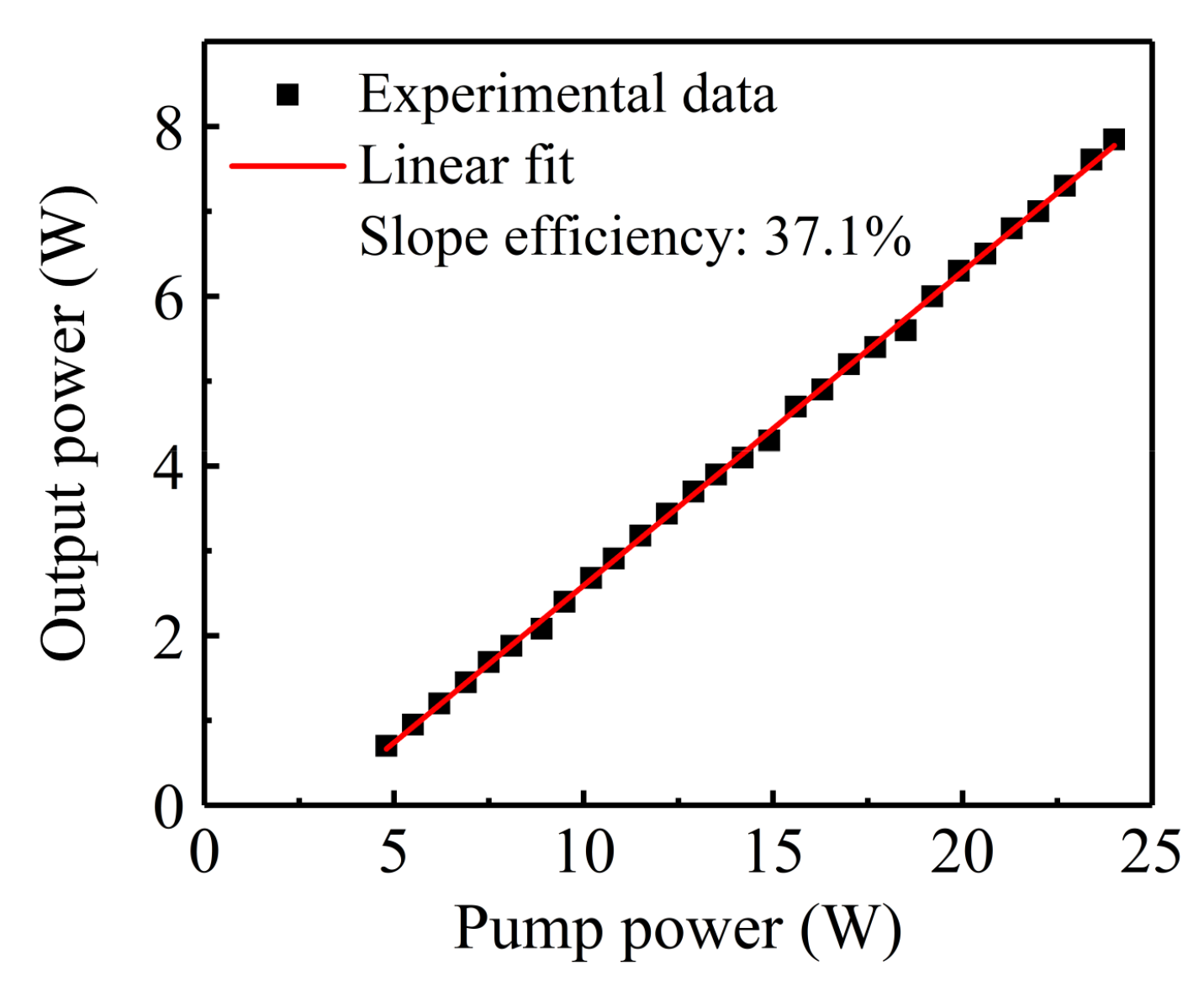


Disclaimer/Publisher’s Note: The statements, opinions and data contained in all publications are solely those of the individual author(s) and contributor(s) and not of MDPI and/or the editor(s). MDPI and/or the editor(s) disclaim responsibility for any injury to people or property resulting from any ideas, methods, instructions or products referred to in the content. |
© 2023 by the authors. Licensee MDPI, Basel, Switzerland. This article is an open access article distributed under the terms and conditions of the Creative Commons Attribution (CC BY) license (https://creativecommons.org/licenses/by/4.0/).
Share and Cite
Guan, B.; Yan, F.; Han, W.; Qin, Q.; Yang, D.; Li, T.; Yu, C.; Wang, X.; Kumamoto, K.; Suo, Y. High-Power, Narrow-Linewidth, Continuous-Wave, Thulium-Doped Fiber Laser Based on MOPA. Photonics 2023, 10, 347. https://doi.org/10.3390/photonics10040347
Guan B, Yan F, Han W, Qin Q, Yang D, Li T, Yu C, Wang X, Kumamoto K, Suo Y. High-Power, Narrow-Linewidth, Continuous-Wave, Thulium-Doped Fiber Laser Based on MOPA. Photonics. 2023; 10(4):347. https://doi.org/10.3390/photonics10040347
Chicago/Turabian StyleGuan, Biao, Fengping Yan, Wenguo Han, Qi Qin, Dandan Yang, Ting Li, Chenhao Yu, Xiangdong Wang, Kazuo Kumamoto, and Yuping Suo. 2023. "High-Power, Narrow-Linewidth, Continuous-Wave, Thulium-Doped Fiber Laser Based on MOPA" Photonics 10, no. 4: 347. https://doi.org/10.3390/photonics10040347
APA StyleGuan, B., Yan, F., Han, W., Qin, Q., Yang, D., Li, T., Yu, C., Wang, X., Kumamoto, K., & Suo, Y. (2023). High-Power, Narrow-Linewidth, Continuous-Wave, Thulium-Doped Fiber Laser Based on MOPA. Photonics, 10(4), 347. https://doi.org/10.3390/photonics10040347






